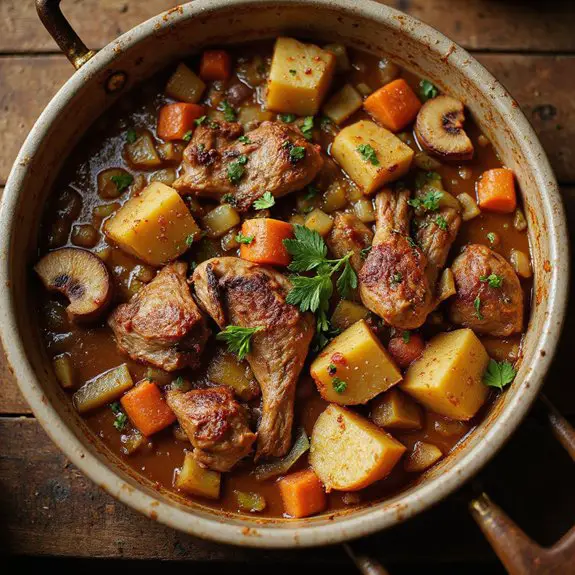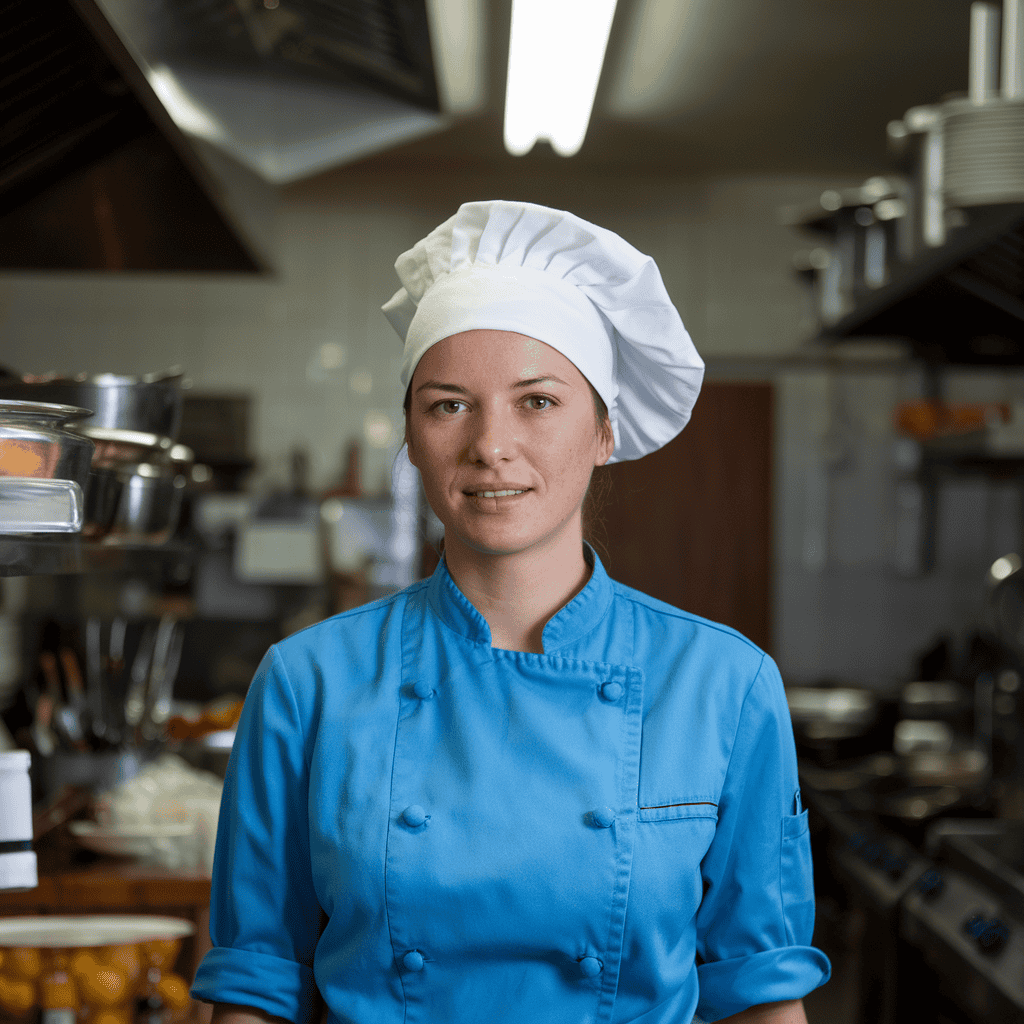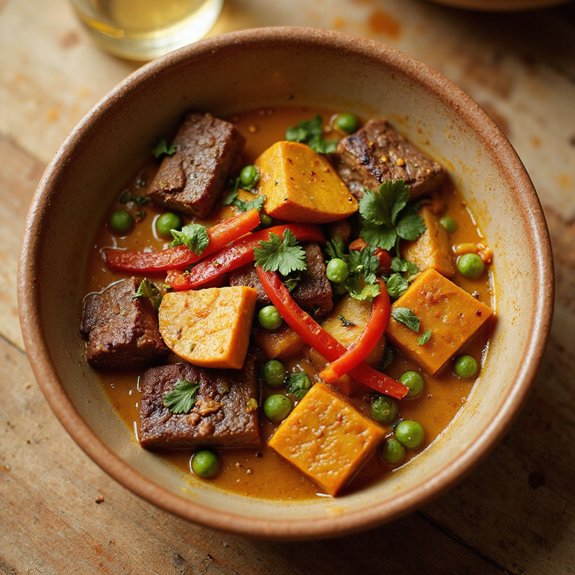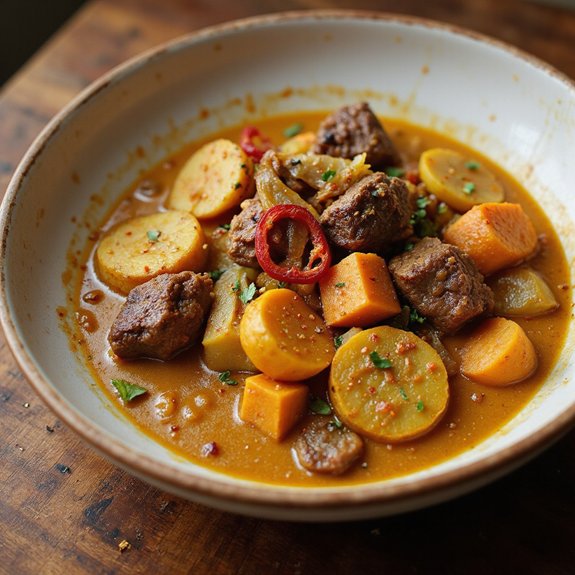Imagine a pot bubbling away with tender rabbit pieces, earthy vegetables, and rich wine melding into a fragrant symphony.
There’s something inherently comforting about rabbit stew; it’s simple to create yet feels like an indulgent escape to the French countryside.
As the ingredients simmer together, they transform into a hearty dish that warms the soul.
Let’s bring this delicious stew to life and savor every flavorful bite.
Kitchen Tools Required
- 1 Dutch oven or large pot
- 1 Cutting board
- 1 Chef’s knife
- 1 Wooden spoon
- 1 Measuring cup
- 1 Measuring spoons set
Ingredients
- 1.5 kg rabbit, cut into pieces
- 2 tablespoons olive oil
- 1 onion, chopped
- 3 cloves garlic, minced
- 2 carrots, sliced
- 2 celery stalks, sliced
- 2 tablespoons tomato paste
- 1 cup red wine
- 2 cups chicken stock
- 1 teaspoon salt
- 1/2 teaspoon black pepper
- 2 bay leaves
- 1 teaspoon dried thyme
- 1 cup mushrooms, sliced
- 3 potatoes, diced
- 2 tablespoons fresh parsley, chopped
Cook & Prep Time
To efficiently manage your time while preparing and cooking Rabbit Stew, here’s a suggested timeline including prep, cooking, and any additional time needed:
Timeline for Rabbit Stew
Preparation:
- Reading the Recipe and Gathering Ingredients (15 minutes):
- Allocate this time to read through the entire recipe and gather all necessary ingredients and equipment.
- Prep Work (15 minutes):
- Cutting Rabbit and Vegetables:
- Cut the rabbit into pieces.
- Chop the onion, mince the garlic, slice the carrots and celery, and dice the potatoes.
- Slice the mushrooms and chop the parsley.
Cooking:
3. Cooking (2 hours):
- Browning the Rabbit (10 minutes):
- Heat olive oil and brown the rabbit pieces on all sides.
- Sautéing Vegetables (10 minutes):
- Remove rabbit, sauté onion, garlic, carrots, and celery until softened.
- Tomato Paste and Wine (5 minutes):
- Stir in tomato paste and cook, then deglaze with red wine.
- Simmering (1 hour 30 minutes):
- Return rabbit to pot, add chicken stock, seasonings, and bring to a boil.
- Reduce heat, cover, and simmer for 1.5 hours.
- Adding Vegetables (30 minutes):
- Add mushrooms and potatoes; continue to simmer until tender.
4. Resting Time (10 minutes):
– Let the stew rest before serving and garnish with fresh parsley.
This timeline will help you stay organized and guarantee that each step flows smoothly into the next, resulting in a delicious Rabbit Stew.
Adjust the timeline based on your cooking pace, allowing extra time if you’re unfamiliar with any techniques.
Recipe Instructions
Heat the olive oil in a Dutch oven over medium-high heat and brown the rabbit pieces on all sides.
Remove the rabbit and set aside, then add the onion, garlic, carrots, and celery to the pot and sauté until softened.
Stir in the tomato paste and cook for an additional 2 minutes.
Pour in the red wine and deglaze the pot, scraping up any browned bits from the bottom.
Return the rabbit to the pot and add the chicken stock, salt, pepper, bay leaves, and thyme.
Bring the mixture to a boil, then reduce the heat to low, cover, and simmer for 1.5 hours.
Add the mushrooms and potatoes, then continue to simmer for another 30 minutes until the vegetables are tender.
Remove the bay leaves, adjust seasoning if necessary, and let the stew rest for 10 minutes before serving.
Garnish with fresh parsley just before serving.
Serving Tips
- Crusty Bread: Perfect for soaking up the rich, flavorful broth of the stew.
- Mashed Potatoes: A creamy side that complements the tender rabbit and vegetables.
- Steamed Green Beans: Adds a touch of vitality and color to the meal.
- Herbed Rice Pilaf: Offers a light, aromatic base to balance the hearty stew.
- Mixed Green Salad: Provides a rejuvenating contrast with its crisp texture and tangy dressing.
Storage
To store rabbit stew, cool it to room temperature.
Then, transfer it to airtight containers.
Refrigerate for up to 3 days.
Alternatively, freeze for up to 3 months for extended preservation.
Freezing
To freeze rabbit stew, let it cool completely.
Transfer to airtight containers, leaving space for expansion.
Label with date.
Freeze for up to 3 months.
Thaw overnight in the refrigerator.
Reheating
To reheat rabbit stew, warm it gently over low heat on the stovetop.
Stir occasionally to guarantee even heating.
Alternatively, microwave it in a covered dish.
Stir halfway to guarantee even heating without drying out.
Final Thoughts
Rabbit stew is a classic French dish that combines tender rabbit meat with a medley of vegetables and aromatic herbs.
This dish not only offers a rich, flavorful experience but also presents an opportunity to explore traditional French cuisine in your own kitchen.
With a preparation time of 30 minutes and a cooking time of 2 hours, rabbit stew is perfect for a weekend meal when you have a bit more time to dedicate to cooking.
This hearty dish serves four, making it an excellent choice for a small gathering or family dinner.
Serve it with crusty bread to soak up the delicious broth and enjoy a comforting meal that will warm you up from the inside out.
Whether you’re new to cooking with rabbit or a seasoned pro, this recipe is sure to impress with its depth of flavor and satisfying texture.
Frequently Asked Questions
Can I Use a Different Type of Meat for Rabbit Stew?
Yes, you can substitute rabbit with chicken or pork. Use the same 1.5 kg weight. Adjust cooking times: chicken cooks faster, about 1 hour, while pork may need an extra 30 minutes for tenderness. Adjust spices accordingly.
How Can I Make Rabbit Stew Gluten-Free?
To make it gluten-free, verify all your ingredients, like chicken stock and tomato paste, are labeled gluten-free. Substitute any flour-based thickeners with cornstarch or omit them entirely for a naturally thickened stew. Enjoy your meal!
What Wine Pairs Well With Rabbit Stew?
You’ll want a medium-bodied wine like Pinot Noir or a Cabernet Franc. These wines complement the stew’s rich flavors. Serve slightly chilled, around 55°F. Pour about 5 ounces per glass for ideal tasting.
How Can I Tenderize Rabbit Meat Before Cooking?
To tenderize rabbit meat, marinate it in 1 cup red wine, 2 tablespoons olive oil, 1 teaspoon salt, and 1 teaspoon dried thyme. Refrigerate overnight. This process breaks down fibers, enhancing tenderness and flavor.
Are There Any Vegetarian Alternatives to Rabbit Stew?
You can substitute rabbit with hearty vegetables like eggplant or mushrooms. Use 1.5 kg of your chosen veggies. Follow the same steps, adjusting seasonings to taste, and guarantee the veggies are evenly sliced for uniform cooking.
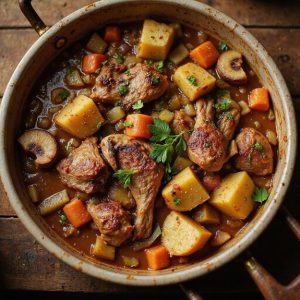
Rabbit Stew
Equipment
- 1 Dutch oven or large pot
- 1 Cutting board
- 1 Chef's knife
- 1 Wooden spoon
- 1 measuring cup
- 1 Measuring spoons set
Ingredients
- 1.5 kilogram rabbit cut into pieces
- 2 tablespoons olive oil
- 1 onion chopped
- 3 cloves garlic minced
- 2 carrots sliced
- 2 celery stalks sliced
- 2 tablespoons tomato paste
- 1 cup red wine
- 2 cups chicken stock
- 1 teaspoon salt
- 1/2 teaspoon black pepper
- 2 bay leaves
- 1 teaspoon dried thyme
- 1 cup mushrooms sliced
- 3 potatoes diced
- 2 tablespoons fresh parsley chopped
Instructions
- Heat the olive oil in a Dutch oven over medium-high heat and brown the rabbit pieces on all sides.
- Remove the rabbit and set aside, then add the onion, garlic, carrots, and celery to the pot and sauté until softened.
- Stir in the tomato paste and cook for an additional 2 minutes.
- Pour in the red wine and deglaze the pot, scraping up any browned bits from the bottom.
- Return the rabbit to the pot and add the chicken stock, salt, pepper, bay leaves, and thyme.
- Bring the mixture to a boil, then reduce the heat to low, cover, and simmer for 1.5 hours.
- Add the mushrooms and potatoes, then continue to simmer for another 30 minutes until the vegetables are tender.
- Remove the bay leaves, adjust seasoning if necessary, and let the stew rest for 10 minutes before serving.
- Garnish with fresh parsley just before serving.

